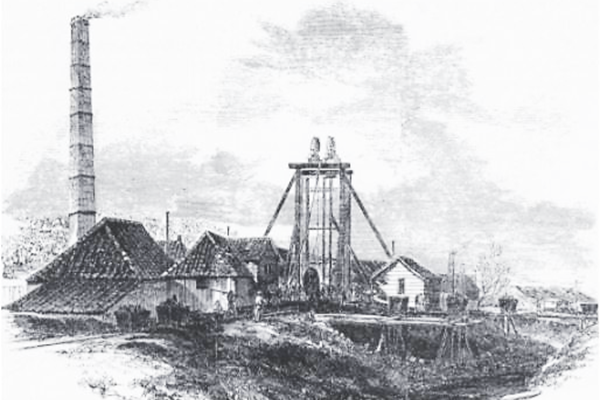Coal Mining & the Victoria Pit Disaster

By 1847, there was considerable competition for jobs in the coal mines, where miners received from 3s.4d to 4s. per day, together with free houses, fires, and gardens. By contrast, labourers earned from 2s. to 2s.3d. per day, without the added benefits of free houses and coal, terms which were considered to be reasonable at that time.
When the coal and iron seams in Hurlet began to fail, pits were sunk in Nitshill. However, the coal seams in were thin and, apart from those sunk to considerable depths, most pits deposits were accessed by removing the upper strata and then open cast mining the coal seams. This process was only economically viable due to the demand for the sandstone, limestone, ironstone and black blaes contained within the extracted upper strata. Remains of some of the horizontal shafts may still be found in the hillsides around Nitshll. The deeper pits were sunk at lower levels and much of Nitshill sits atop pit galleries.
Undoubtedly, the most important of these deep pits were the Victoria Pit and the Free-Trader Pit, which were connected by a warren of abandoned underground workings. Owned by the famous Coats family of Paisley, the two pits were considered to be the most up-to-date and most safety-conscious in the country. As with all mineral extraction processes, coal mining in and around Nitshill and Hurlet was dangerous. This is evidenced by the following extracts from the New Statistical Account, 1847:
This coal contains sulphur, and thereby possesses the property of caking when exposed to heat. The miners remark, that sulphur always exists in coal, lying immediately beneath limestone.
The Hurlet mines at one time contained inflammable air, and through the negligence of some workmen in not using the necessary precautions, several valuable lives have been lost. Such accidents, however, are now in a great measure dissipated by the free circulation of atmospheric air throughout the waste, and the numerous pits or shafts communicating with each other.
In May 1818 one of these mines at Quarrelton was overflowed with water, and five of the miners perished. Two of the others were rescued alive, after having been immured in the gloomy dungeon for ten days. A very interesting account of all the circumstances of this event is given in the Scots Magazine for 1819, p. 33 - the statement was drawn up from the accounts of the men who escaped, both of whom, two brothers of the name of Hodgert, are still living."
Commentators have since suggested that Nitshill collieries ‘featured as a killing ground from the 1830s’, citing an explosion at Doves Colliery on August 19th, 1832, which killed four miners and injured a further three. The explosion was deemed to be due ‘to middle management pig headedness’. The report goes on to state that:
…the overseer would not believe the men [that] there was gas in the workings, believing they wishes the day off as it was Reform Jubilee Day in Barrhead, and thus for most a local holiday. Rennie, the overseer, bullied and cajoled the men into going back into the workings and full of bravado he carried a normal lamp. The resulting explosion brought local villages running and the dead and survivors were got clear. Rennie and two others lay dead on the turf; Abraham Thomson, one of the injured, was carried home and put to bed, a lamp knocked over on him as he lay there [and] burnt him again, this time to his death.'
Source: https://www.nmrs.org.uk/assets/pdf/BM41/BM41-76-98-renfrewshire.pdf
These tragedies were soon to be overshadowed by a disaster at the Victoria Colliery in 1851, then the deepest pit in Scotland. The Victoria was on what is now the northern part of the big wooded parkland area off Glenmuir Drive, whilst the Freetrader Pit was located approximately 0.7 miles away, somewhere between what are now the Craigbank shops and the residential streets of Craigbank Drive and Drumbeg Drive. The disaster is estimated to have occurred at a point somewhere between the Victoria and the Free Trader.
The tragedy of Victoria Pit is, here, recorded in contemporary newspapers and reports from the time.
